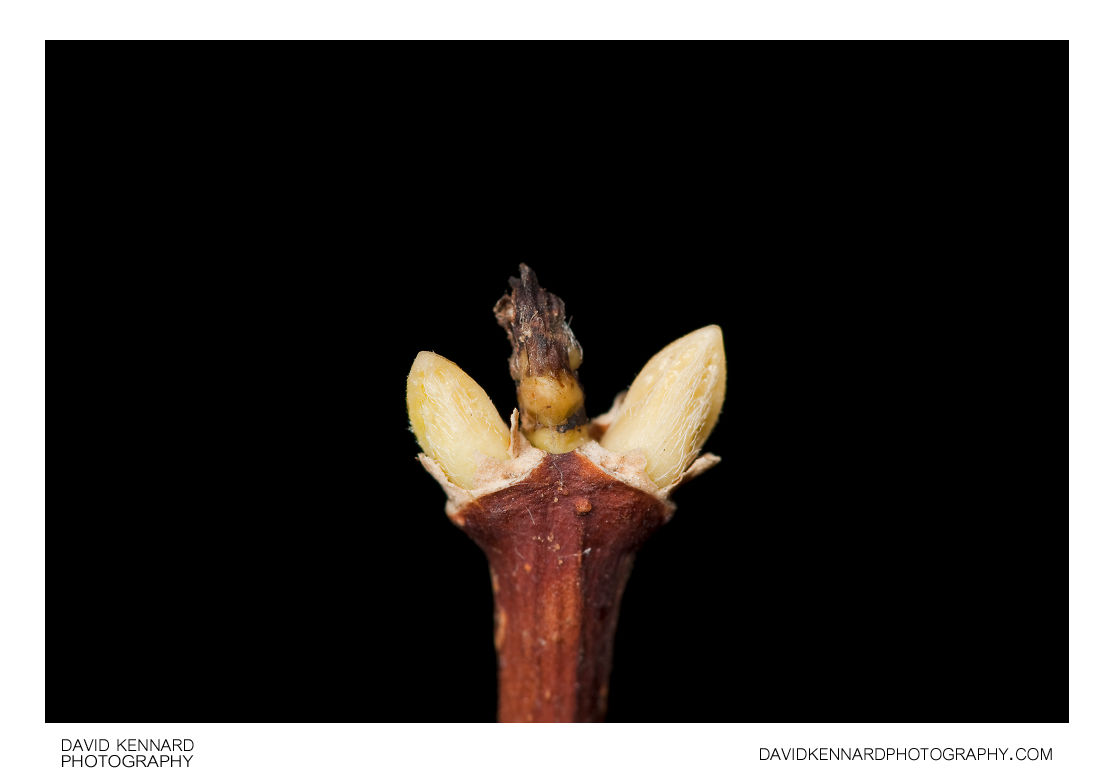Golden Mock-orange (Philadelphus coronarius aureus) leaf buds

Description
- Title:
- Golden Mock-orange (Philadelphus coronarius aureus) leaf buds
- Caption / Description:
-
In botany, a bud is an undeveloped or embryonic shoot and normally occurs in the axil of a leaf or at the tip of the stem. Once formed, a bud may remain for some time in a dormant condition, or it may form a shoot immediately.
The buds of many woody plants, especially in temperate or cold climates, are protected by a covering of modified leaves called scales which tightly enclose the more delicate parts of the bud. Many bud scales are covered by a gummy substance which serves as added protection. When the bud develops, the scales may enlarge somewhat but usually just drop off, leaving on the surface of the growing stem a series of horizontally-elongated scars. By means of these scars one can determine the age of any young branch, since each year's growth ends in the formation of a bud, the formation of which produces an additional group of bud scale scars. Continued growth of the branch causes these scars to be obliterated after a few years so that the total age of older branches cannot be determined by this means.
In many plants scales are not formed over the bud, which is then called a naked bud. The minute underdeveloped leaves in such buds are often excessively hairy. Such naked buds are found in shrubs like the Sumac and Viburnums and in herbaceous plants. In many of the latter, buds are even more reduced, often consisting of undifferentiated masses of cells in the axils of leaves. A terminal bud occurs on the end of a stem and lateral buds are found on the side.
Description above from Wikipedia article: http://en.wikipedia.org/wiki/Buds
Philadelphus coronarius aureus, or Golden Mock-orange, is a cultivar of Philadelphus coronarius. The aureus cultivar has bright golden yellow leaves, and is a popular shrub in gardens.
- Tags / Keywords:
-
- New Growth
- Biota
- Life
- Vitae
- Eukaryota
- Plantae
- Plants
- Magnoliophyta
- Flowering Plants
- Angiosperms
- Magnoliopsida
- Dicotyledons
- Cornales
- Hydrangeaceae
- Hydrangeas
- Philadelphus
- Mock Orange
- Philadelphus coronarius
- Sweet Mock Orange
- English Dogwood
- Philadelphus coronarius Aureus
- Golden Mock Orange
- Buds
Admin
- Date Original Photo Taken:
- Original File Name:
- _MG_8380.CR2
- Event:
- Rating:
- ☆
- Date this image added/last updated on website:
- Original File Dimensions:
- 4272px x 2848px
- File Type:
- JPEG
- Color Mode:
- RGB
- Original Image Color Profile:
- Adobe RGB (1998)
Location
- Location Created:
-
- Sublocation:
- City:
- Market Harborough
- Province/State:
- Leicestershire
- Country:
- United Kingdom
- World Region:
- Europe
- Geo-location:
Rights
- Copyright Status:
- Copyrighted
- Licensing Status:
- Rights Managed
- Available for Editorial Use:
- Yes
- Available for Commercial Use:
- Yes
- Copyright Notice:
- © 2010 Dave Kennard
Camera Data
- Date Digital Resource was created:
- Shutter speed:
- 1⁄200 s
- Aperture:
- f/7.1
- Camera Model:
- Canon EOS 450D
- ISO:
- 100
- Exposure Compensation:
- 0
- Focal Length:
- 100mm
- Focal Length (35mm equiv.):
- Metering Mode:
- Multi-segment
- Flash:
- On, Fired
- Exposure Mode:
- Manual
- White Balance:
- Manual
- Light Source:
- Exposure Program:
- Manual
Additional shooting metadata
- Lens:
- Canon MP-E 65mm F2.8 1-5x Macro
- Filters used:
- Additional Optics used:
- Setup:
- Handheld
Canon MT-24EX Macro Twin Flash with home-made diffusers
Post Processing
- Image Modified:
- Software used:
-
- Adobe Camera RAW
- Post Processing:
